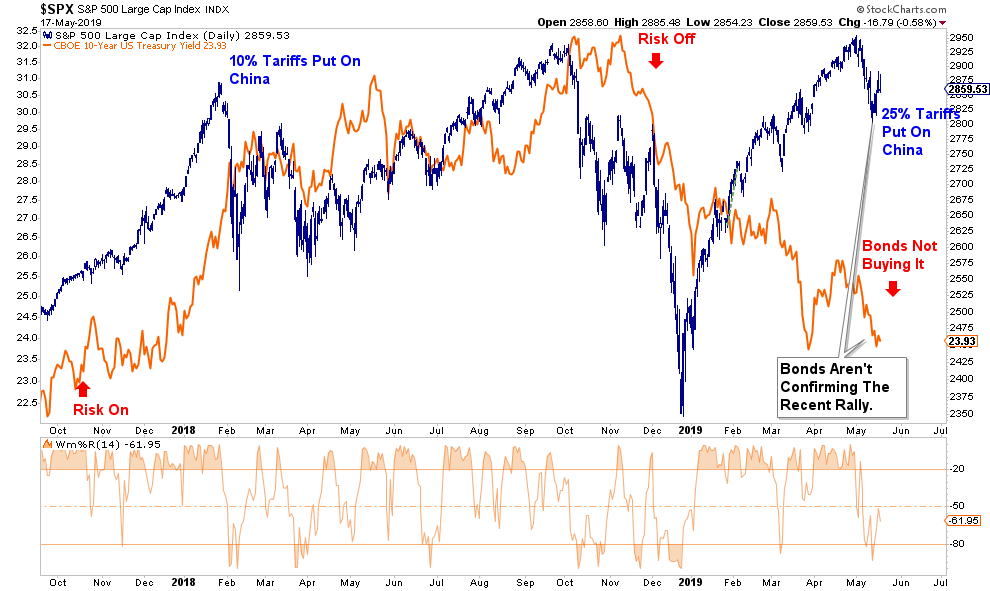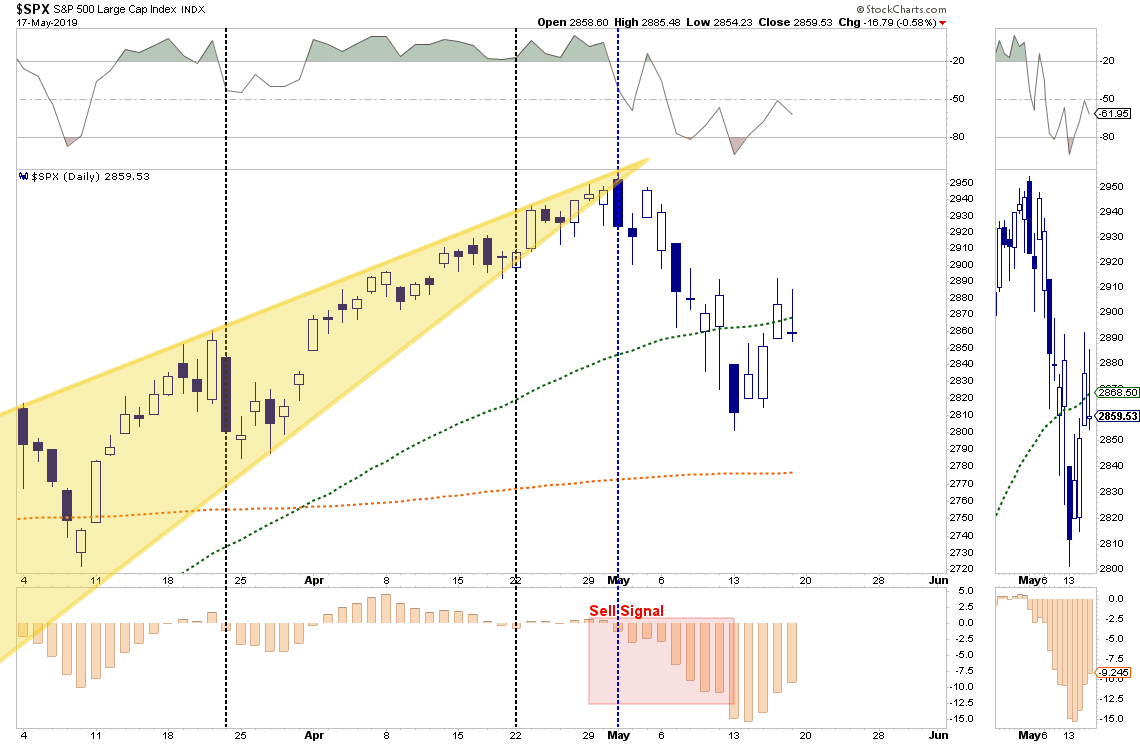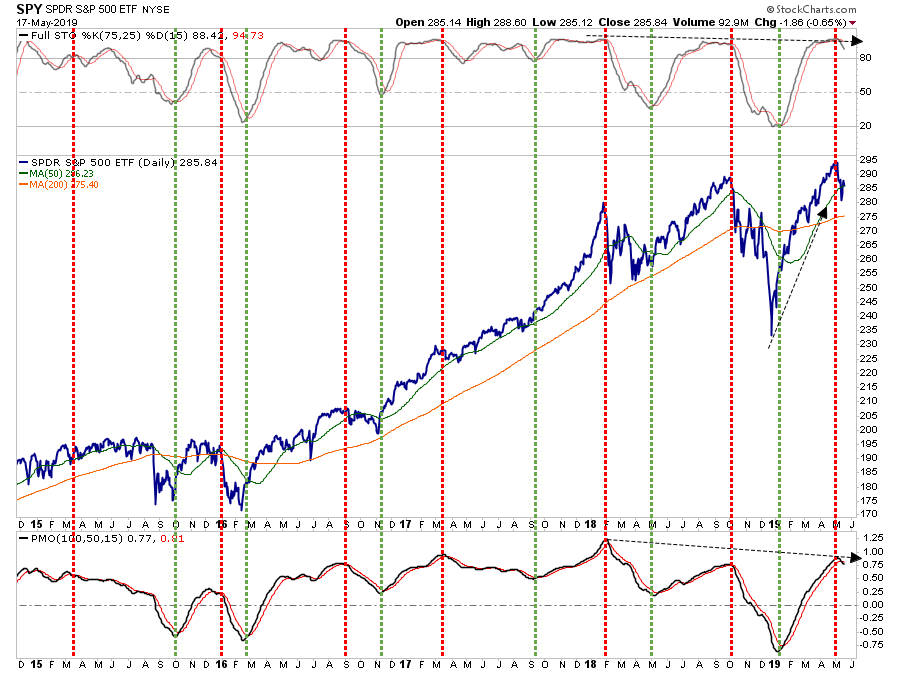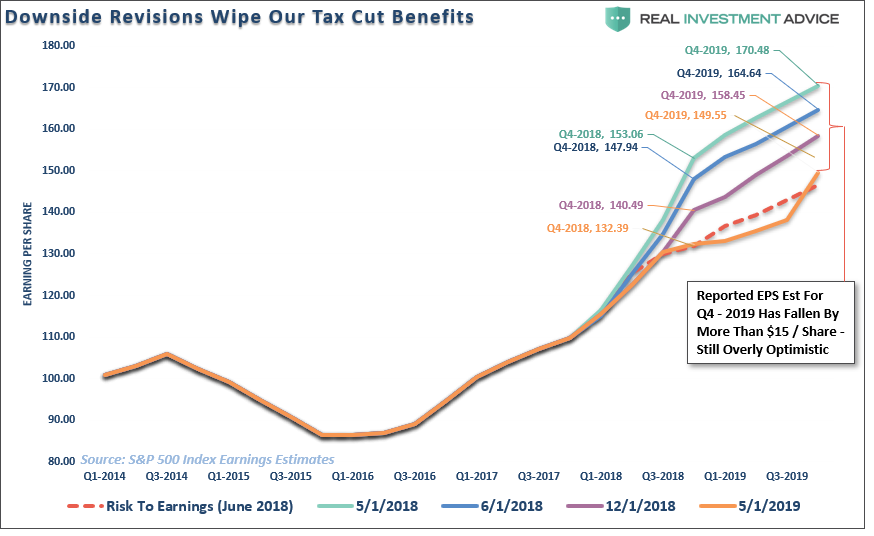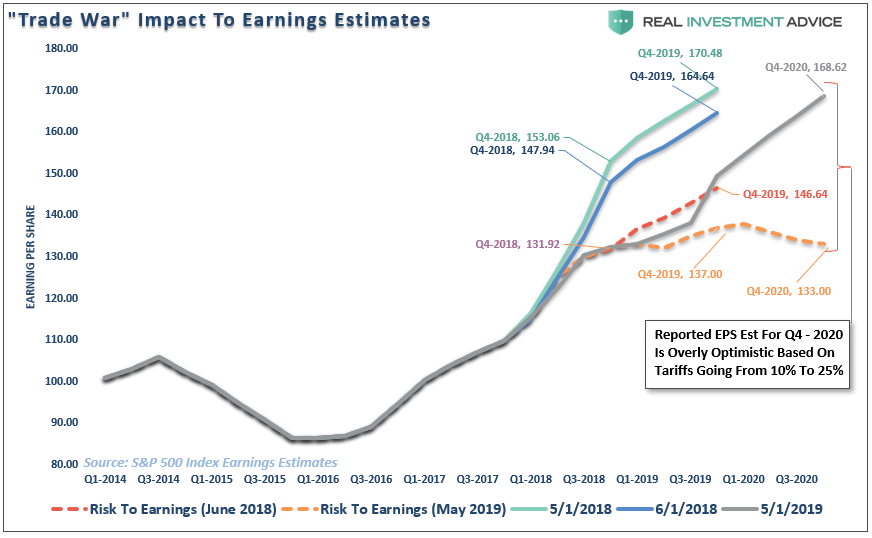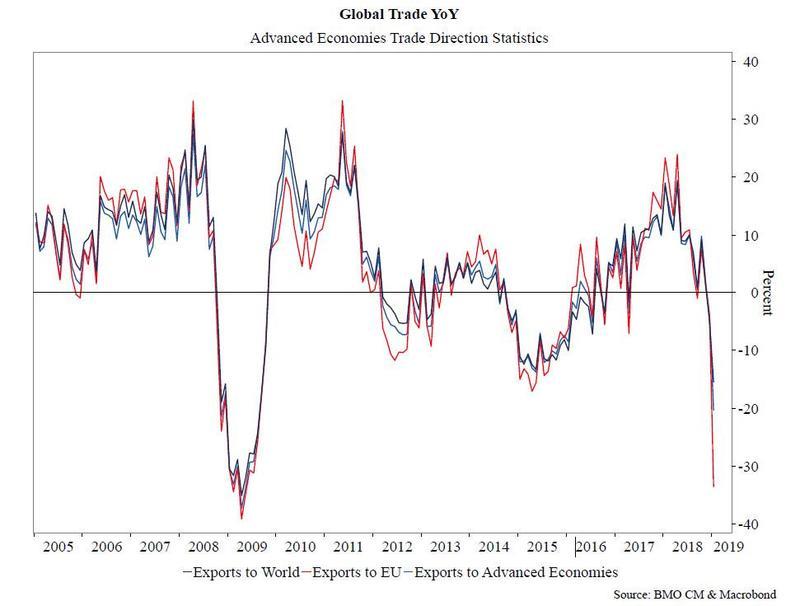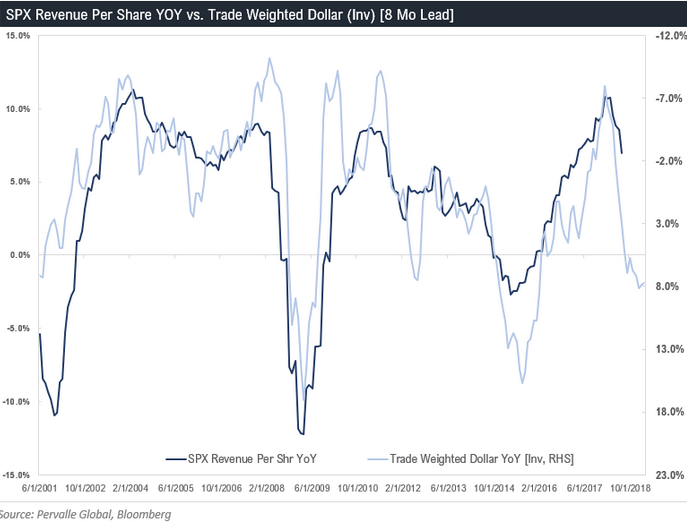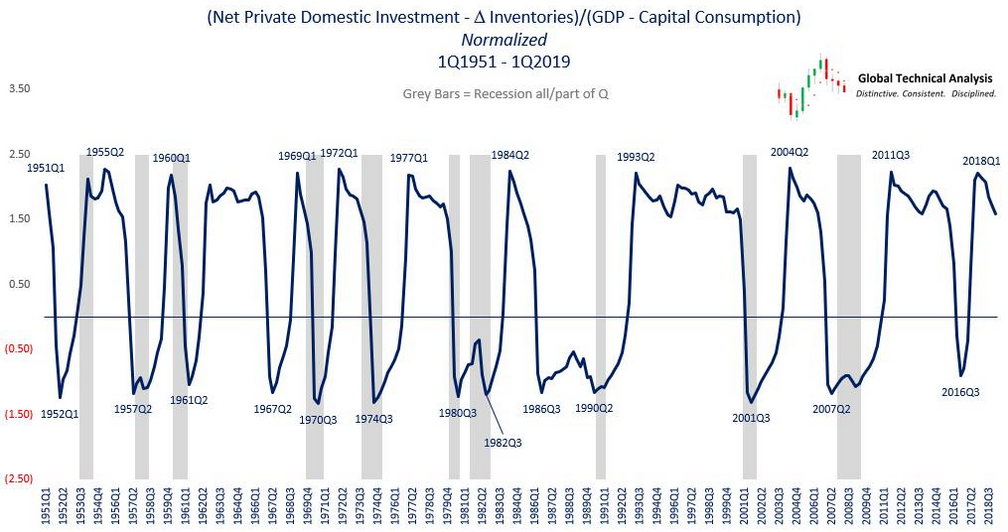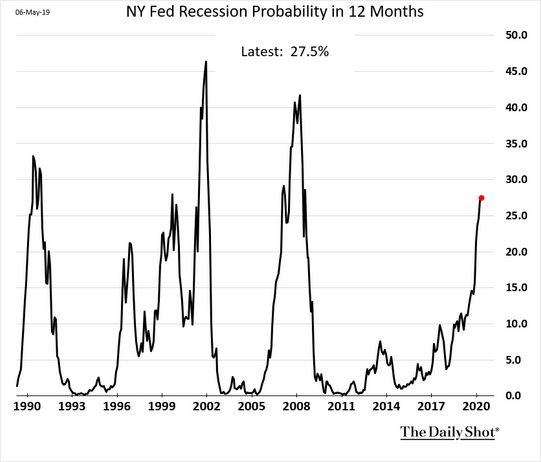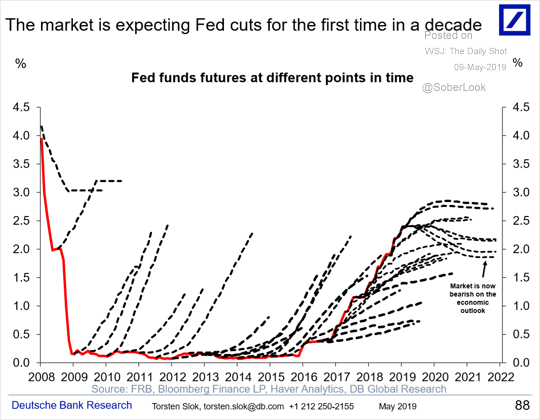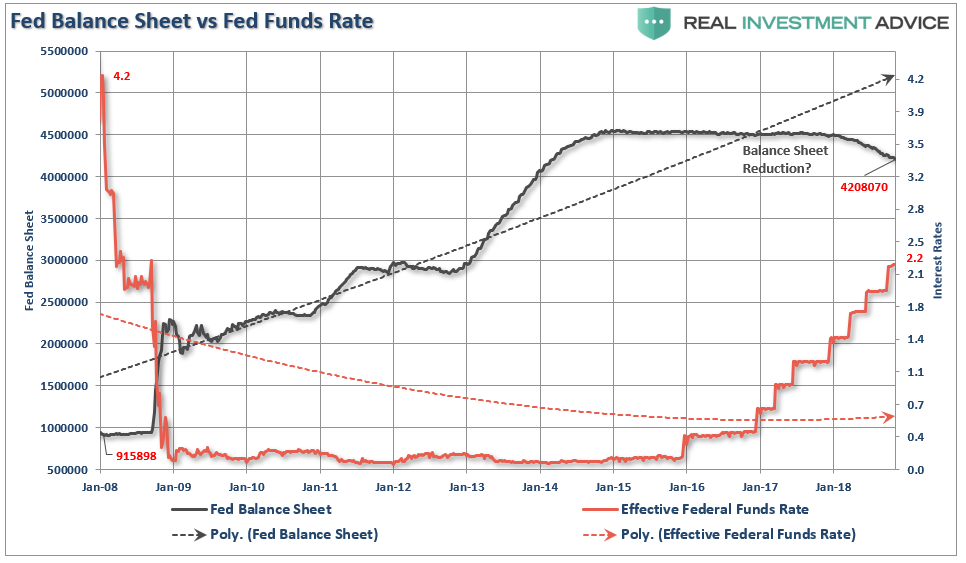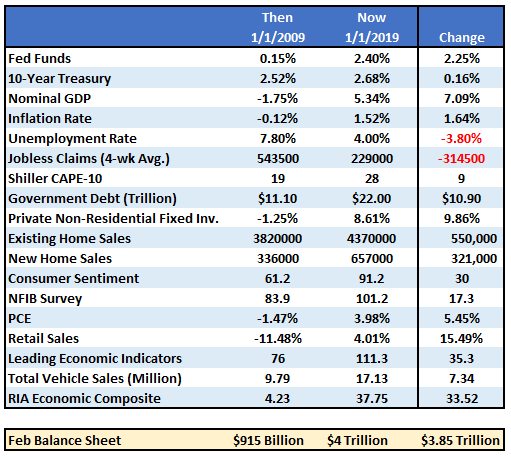Authored by Lance Roberts via RealInvestmentAdvice.com,
Over the last several weeks, we have been discussing the potential for a market correction simply due to divergences in the technical indicators which suggested near-term market risk outweighed the reward. Then, the White House reignited the “trade war” with China. To wit:
“The “Trade War” is not a good thing for markets or the economy as recently suggested by the President. David Rosenberg had an interesting point on this as well on Friday:
‘Tracing through the GDP hit from a tariff war on EPS growth and P/E multiple compressions from heightened uncertainty, the downside impact on the S&P 500 would come to 10%. I chuckle when I hear economists say that the impact is small- meanwhile, global trade volumes have contracted 1.1% over the year to February…how is that bullish news exactly?’
Remember, at the beginning of 2018, with ‘tax cuts’ just passed, and earnings growing, the market was set back by 5% as an initial tariff of 10% was put into place. Fast forward to today, you have tariffs going to 25%, with no supportive legislation in place, earnings growth and revenue weakening along with slower economic growth.
In the meantime, the bond market is screaming ‘deflation,’ and yields have clearly not been buying the 3-point multiple expansion from the December 24th lows.”
It was due to that analysis, and the trade war, that we made the following recommendations last week to our clients and RIA PRO subscribers. (Try NOW and get 30-days FREE)
“Continuing from yesterday’s discussion on the impact of ‘trade wars’ on various sectors has us beginning to reposition out of some the areas most susceptible to tariffs. Yesterday, we closed out our position in Emerging Markets, and sold 1/2 of our position in Basic Materials.
Today, on the bounce as laid out yesterday, we sold half of our position in XLI (industrials) and XLY (consumer discretionary) and added one-half position in XLRE (real estate) which should be defensive with lower interest rates.“
We still maintain a long-bias towards equity risk. But, that exposure is hedged with cash and bonds which remain at elevated levels. (If you haven’t taken any actions at all recently, read my previous newsletter for Portfolio Management Guidelines)
While the market got very oversold previously, we noted last weekend a bounce was likely.
Unfortunately, that bounce was unable to hold above the 50-dma on Friday which negates the break above it earlier in the week. Importantly, the deeply oversold condition was somewhat reversed which now sets the market up for a potential retest of the 200-dma average over the next couple of weeks. A failure at that level and we have to start having a different conversation about portfolio allocation models.
For now, the market is working a corrective process which is likely not complete as of yet. As we head into the summer months, it is likely the markets will experience a retracement of the rally during the first quarter of this year.As shown in a chart we use for position management (sizing, profit taking, sells) the market has just issued a signal suggesting risk reduction is prudent. (This doesn’t mean sell everything and go to cash.)
There is no “law” that says you have to be “all in” the market “all the time.”
Every good gambler knows how to “size their bets” relative to the “hand they hold.” This is particularly the case when it certainly appears the “bulls are betting on a long shot.”
Betting On A Long-Shot
Last week, we discussed in a lot of detail the re-escalation of the “trade war” and the potential impact to earnings in the quarters ahead. To wit:
“As a result of escalating trade war concerns, the impact in the worst-case scenario of an all-out trade war for US companies across sectors and US trading partners will be greater than anticipated. In a nutshell, an across-the-board tariff of 10% on all US imports and exports would lower 2018 EPS for S&P 500 companies by ~11% and, thus, completely offset the positive fiscal stimulus from tax reform.
Fast forward to the end of Q1-2019 earnings and we find that we were actually a bit optimistic on where things turned out.”
“The problem is the 2020 estimates are currently still extremely elevated. As the impact of these new tariffs settle in, corporate earnings will be reduced. The chart below plots our initial expectations of earnings through 2020. Given that a 10% tariff took 11% off earnings expectations, it is quite likely with a 25% tariff we are once again too optimistic on our outlook.”
“Over the next couple of months, we will be able to refine our view further, but the important point is that since roughly 50% of corporate profits are a function of exports, Trump has just picked a fight he most likely can’t win.
Importantly, the reigniting of the trade war is coming at a time where economic data remains markedly weak, valuations are elevated, and credit risk is on the rise. The yield curve continues to signal that something has ‘broken,’ but few are paying attention.”
For the bullish narrative, the earnings growth story is going to become increasingly difficult to ignore. This is particularly the case given that just this past week economic data continues to show weakness. As shown in the following chart, global economic trade has collapsed to levels not seen since prior to the financial crisis.
Of course, since almost 50% of corporate revenue and profits are generated from international activity, it is not surprising to see a problem emerging.
As J. Brett Freeze, CFA discussed on Friday, dissected the key drivers of economic growth: Capital Expenditures.
The graph shows that when the economy is coming out of recession and optimism is budding, capital expenditures as a percentage of the economy are high. Conversely, as optimism wanes, and the economic cycle is long in the tooth capital expenditures peak, trend sideways and then drop sharply. (The data in the graph is normalized using six quarter moving averages and standard deviations as reflected on the Y-axis.)
The 1960s and the current period are unique in that those periods saw a sharp decline in capital expenditures that did not lead to a recession. We know the current episode is a result of a resurgence of corporate optimism due to the election of Donald Trump and importantly, the corporate tax cut that incentivized corporate spending. With much of the tax cut stimulus behind us, the temporary fiscal boost appears to be fading.
Unsurprisingly, all of this data aligns with rising recession risks.
(Important Note: The graph above is based on lagging economic indicators which are subject to huge negative revisions in the future. Therefore, high current risk levels should not be readily dismissed as the recession will have started before the data is revised to reveal the actual start date.)
Here is my point.
If you had been living on Mars for the last 24-months and just reviewed the data above, you would, most logically, assume the market would be down, and probably significantly so.
That certainly isn’t the case, as noted above, with the markets just a couple of percentage points away from their all-time highs. So, despite the data, the resurgence of a “trade war” with China, rising delinquency rates and falling demand for loans, and weak outlooks by businesses, the bulls are certainly “betting on a long-shot” of an outcome that is currently well outside the current data.
In that is the case, then what are the “bulls” betting on? My friend Patrick Hill sent me a good note on this issue.
“In watching Bloomberg, it seems the market is betting on:
1 – The Fed will lower interest rates. The Fed Funds rate forecast shows at least once this year. Interestingly, historically, when the Fed begins lowering interest rates it has been in response to a recession, not a slowdown.
2 – The trade war will not be as bad as thought as Trump and Xi will meet at G20 and resolve everything. But that may not be the case given China’s positioning on Friday:
“The US has completely abandoned commercial principles and disregarded law. Its barbaric behavior against Huawei by resorting to administrative power can be viewed as a declaration of war on China in the economic and technological fields. It is time that the Chinese people throw away their illusions. Compromise will not lead to US goodwill.”
3 – Corporations can continue to churn out revenue growth as China stimulus will help out EM countries and US companies can sell to them
4 – Corporate debt at levels at record highs, and leveraged loans at twice the level of subprime debt in 2008, is of no real concern.
5 – Corporate stock buybacks will continue to provide a bid to the market. (Of course, what happens when sales continue to fall.) Ned Davis research noted their research shows the S & P is up 19 % over what it would not be without buybacks. Buybacks have also made up about 80% of the “bid” to the market.
6 – There is no concern that tariffs will push price inflation higher despite the fact that tariffs will lift costs on both consumers and businesses.
7 – The Fed will respond to any weakness providing a permanent bid the market.
In other words, at the moment, data doesn’t matter to the markets – it is simply “hope” based momentum magnified with a “crap ton” of liquidity (Yes, that is a technical term.)
Doug Kass recently discussed the issue of the current disconnect.
“‘(Very) leveraged strategies involving yield enhancement, allocations based on risk assessment (risk parity) and other volatility targeting funds are contributing factors to a new and heightened regime of volatility that has recently intensified. And so does the popularity and proliferation of passive ETFs and the proliferation of CTA (extreme momentum-based) strategies, exaggerate short term price moves. (Even BlackRock’s Larry Fink has missed this important reason for the market’s sharp advance this year).
There is such a limited discussion of the enormous sums of money that are now being managed by Quants and Pseudo Quant hedge funds, algorithmic trading with MASSIVE leverage, all of which dominates the investing landscape.
The aforementioned strategies (based on momentum and the assessment of asset class risk), embraced by many, work until they don’t and when a trend changes (from up to down) massively levered products (like risk parity) are forced to delever and buy back volatility (to offset their short vol positions) – further exacerbating the move lower.
The problem, of course, is ‘uncovered’ when too many are on the same side of the boat.
A state of stability should not be as trusted as much today as in the past it will likely morph into more frequent episodes of instability – a series of ‘Minsky Moments.’”
This is an important point, stability eventually breeds instability due to the buildup of “complacency.” The entire bullish “bet” currently is that despite a growing laundry list to the contrary, the markets will continue their advance simply waiting for the data to improve.
Primarily, this belief is hinged on the idea the Fed will come to the rescue. The problem, as noted previously:
“The effectiveness of QE, and zero interest rates, is based on the point at which you apply these measures. In 2008, when the Fed launched into their ‘accommodative policy’ emergency strategy to bail out the financial markets, the Fed’s balance sheet was only about $915 Billion. The Fed Funds rate was at 4.2%.”
If the market fell into a recession tomorrow, the Fed would be starting with roughly a $4 Trillion balance sheet with interest rates 2% lower than they were in 2009. In other words, the ability of the Fed to ‘bail out’ the markets today, is much more limited than it was in 2008.
But there is more to the story than just the Fed’s balance sheet and funds rate. The entire backdrop is completely reversed. The table below compares a variety of financial and economic factors from 2009 to present.”
“The critical point here is that QE and rate reductions have the MOST effect when the economy, markets, and investors have been ‘blown out,’ deviations from the “norm” are negatively extended, confidence is hugely negative. In other words, there is nowhere to go but up.”
That is hardly the case currently as prices have become detached from both the economic and fundamental cycles of the market. The bulls are clinging to narratives to justify excessive valuations and deviations from the norm.
“We live in an investment world in which much of the silly, fairy tale narratives have little to do with the real world – a lot is basically “made up.” It is that simple.” – Doug Kass, Real Money Pro
So, what are we doing now?
We realize that out clients have to make money when markets are rising, but that we also have to manage the risk of loss.
It’s an incredibly tough job and doesn’t always work out the way we plan. But that is the essence of investing to begin with.
With the recent market weakness, we are holding off adding to our equity “long positions” until we see where the market finds support. We have also cut our holdings in basic materials and emerging markets as tariffs will have the greatest impact on those areas. Currently, there is a cluster of support coalescing at the 200-dma, but a failure at the level could see selling intensify as we head into summer.
The recent developments now shift our focus from “risk taking” to “risk control.” “Capital preservation strategies” now replace “capital growth strategies,” and “cash” now becomes a favored asset class for managing uncertainty.
As a portfolio manager, I must manage short-term opportunities as well as long-term outcomes. If I don’t, I suffer career risk, plain and simple. However, you don’t have to. If you are truly a long-term investor, you have to question the risk being undertaken to achieve further returns in the current market environment.
